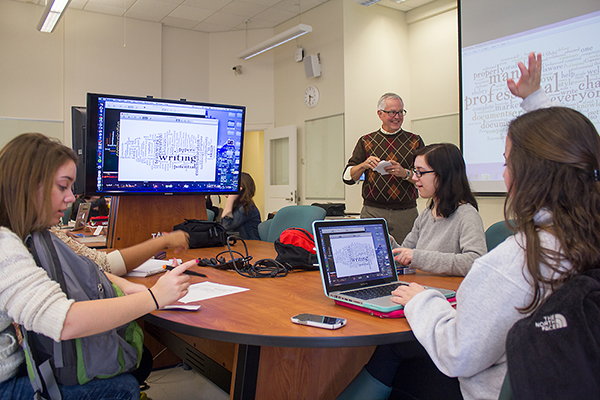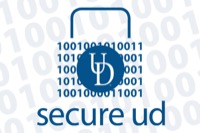
Flexible classrooms, successful students
English department's Stephen Bernhardt reflects on changes in UD classrooms
(Editor's note: This article is part of a continuing series by University IT on innovative use of technology in campus classrooms.)
12:54 p.m., April 30, 2015--University of Delaware English professor Steve Bernhardt has eliminated paper from his writing classes. His students now work at tables in small groups and share their writing on large screens at their team tables or with the full class.
Bernhardt, the Andrew B. Kirkpatrick, Jr. Chair in Writing and the director of the Institute for Transforming Undergraduate Education (ITUE), has been teaching writing classes since arriving at UD 15 years ago. Since then, he has been able to adapt technology to help his students’ work become increasingly collaborative.
FYI Stories
June 6: UDid It! Picnic
2FA protects you
Bernhardt has always been interested in incorporating problem-based learning (PBL) and team-based learning into his classroom. One of his goals has been to create spaces where writers could benefit from immediate feedback and real-time coaching.
In the past, incorporating technology into the classroom meant relying heavily on the presence of traditional computer labs using installed commercial software. When wireless connectivity and shared document platforms became available, Bernhardt immediately jumped on the opportunity to include these in his classes in Memorial Hall and Gore Hall.
“Initially there were concerns from some faculty about students being so ‘connected’ in the academic setting,” Bernhardt explained, “but in a writing classroom, it’s really important for students to be connected to information, able to access research tools, and able to share texts with each other.”
He added that although having connected devices in the classroom can be a potential distraction, instructors can structure class time in ways that keep students on track if the tasks are well defined and lead to improved student writing.
According to Bernhardt, there are a few key elements of a well-designed team-based learning space:
- surfaces available for writing, including walls and boards;
- technology that focuses the groups’ mental activity, such as one screen that all seats surround;
- furniture that can be rearranged according to meet the specific needs of different classroom activities; and
- space for free movement of teachers and students throughout the room.
Using screens as a focal point for group work has increased group collaboration. For example, a team of students can open a Google Document and all contribute simultaneously to writing and editing. Allowing students to get their writing in front of other people facilitates peer commentary and review. At the same time, students learn the necessary markup tools to complete these tasks.
In classrooms like Memorial 110 and Gore 218, student laptops quickly connect to shared screens, either wirelessly or with a cable, so that each group can review each other’s work. In Bernhardt’s classes, students can also access their textbook, Writer’s Help, from Bedford/St. Martin’s, so they can quickly look up what they need to know: how to sharpen a thesis statement, format a reference in APA style, or choose the right word, e.g., affect or effect.
“Learning in a problem-based learning classroom provides students with good practice in collaborative skills they’ll use in their careers,” Bernhardt said. “In many workplaces, our graduates will be collaborating on written texts, reviewing the writing of others, and working at a distance with other team members.”
These complex behaviors can be developed in UD’s team-based classrooms. The collaborative relationships established in class can then support continued work outside of class, conducted through connected devices.
Bernhardt noted that having more technology in the classroom furthered his main teaching goal: to help students develop technical and interpersonal skills, creating a foundation for the students’ continued independent learning in writing.
“There is a lot of collateral learning in a writing classroom that enables the use of technology, collaboration, and peer review — all of which is part of writing,” Bernhardt observed.
In his various roles at the University, Bernhardt has worked to incorporate these elements into classrooms across campus. He has worked with faculty in health sciences on the Science, Technology and Advanced Research (STAR) Campus and in mathematical sciences, where professors wanted not only to increase the level of collaboration among students, but also to increase the amount of collaborative writing that the students produced.
“Having access to these flexible classrooms was crucial to successfully stressing the importance of collaborative writing and teamwork in solving problems,” he said.
“We are in a much better position with team-based classrooms than we ever were before. We’ve got great new classrooms in ISE Lab and in Alison Hall. The Registrar’s Office can be very responsive to requests for these new flexible seating classrooms,” Bernhardt added.
With the increased success of team-based learning classrooms, administrators across the University are providing screens in informal learning spaces so students can work collaboratively anytime. The library, the student centers and ISE Lab are all places where students work in study groups, facilitated by technologies.
The continued development of these elements in and out of the classrooms demonstrates UD’s commitment to the continued development of its teaching practices to better prepare students for their future careers.
About Stephen Bernhardt
Stephen A. Bernhardt holds the Andrew B. Kirkpatrick, Jr. Chair in Writing at the University of Delaware, a position dedicated to promoting strong writing and communication skills across the university. He is the author of Writer’s Help, a w eb-based reference handbook from Bedford/St. Martin’s.
He teaches courses in scientific and technical communication, first-year composition, computers and writing, and grammar and style. He team-teaches “Math through Technology” with Alfinio Flores and “Business, Ethics and Communication in the Life Sciences” under an IGERT grant with Kelvin Lee, Scott Jones, Steve Tague and Tom Powers.
He is also the director of the Institute for Transforming Undergraduate Education (ITUE) at UD, a group of faculty who promote active, engaged learning through team, problem and project-based teaching, frequently with an emphasis on innovative technologies.
Further information
Learn more about Bernhardt’s work in flexible seating classrooms: Bernhardt and Downs, Gore 218
Article by Lauren Elise Maxfield
Photograph by Paul Hyde








